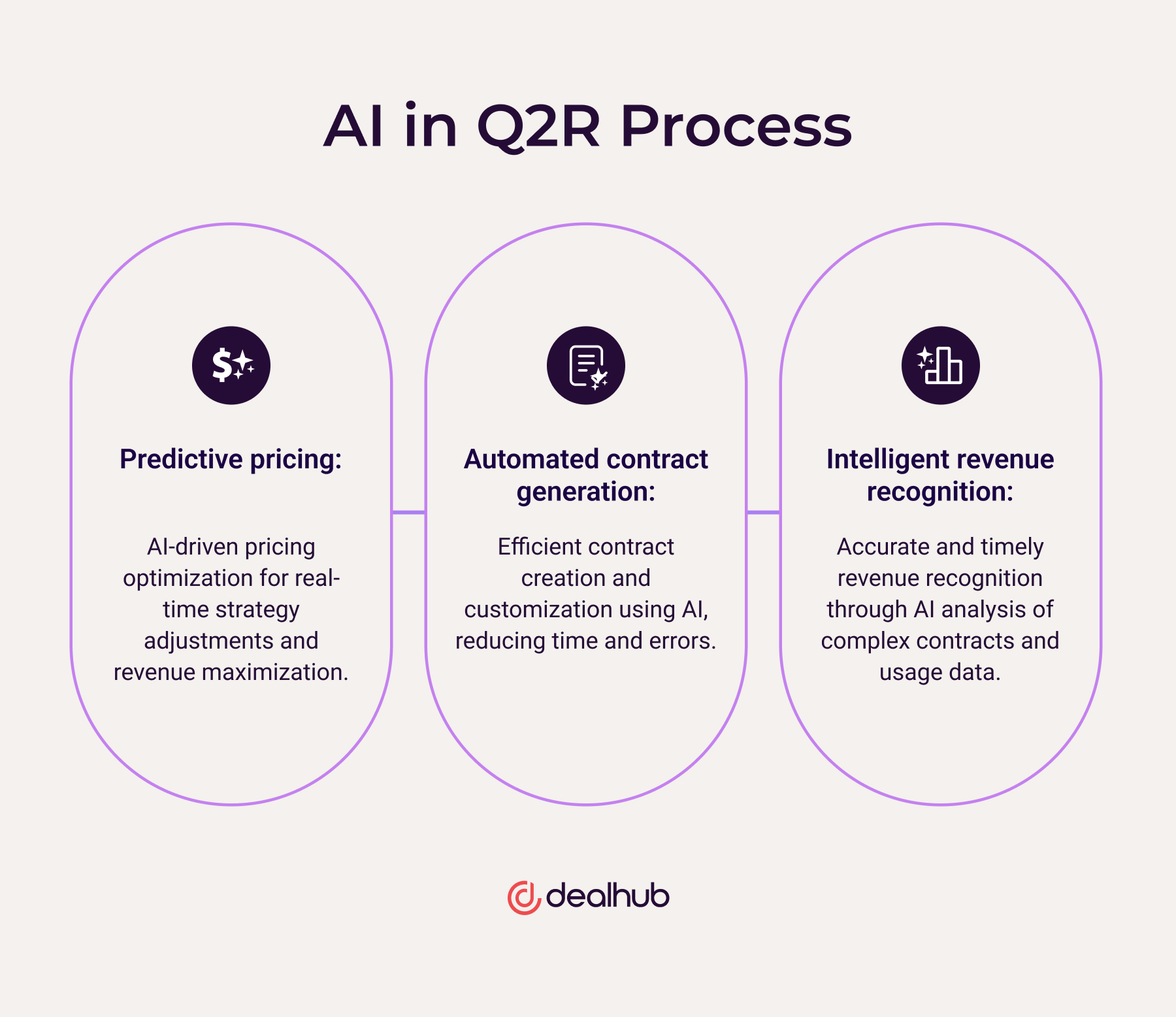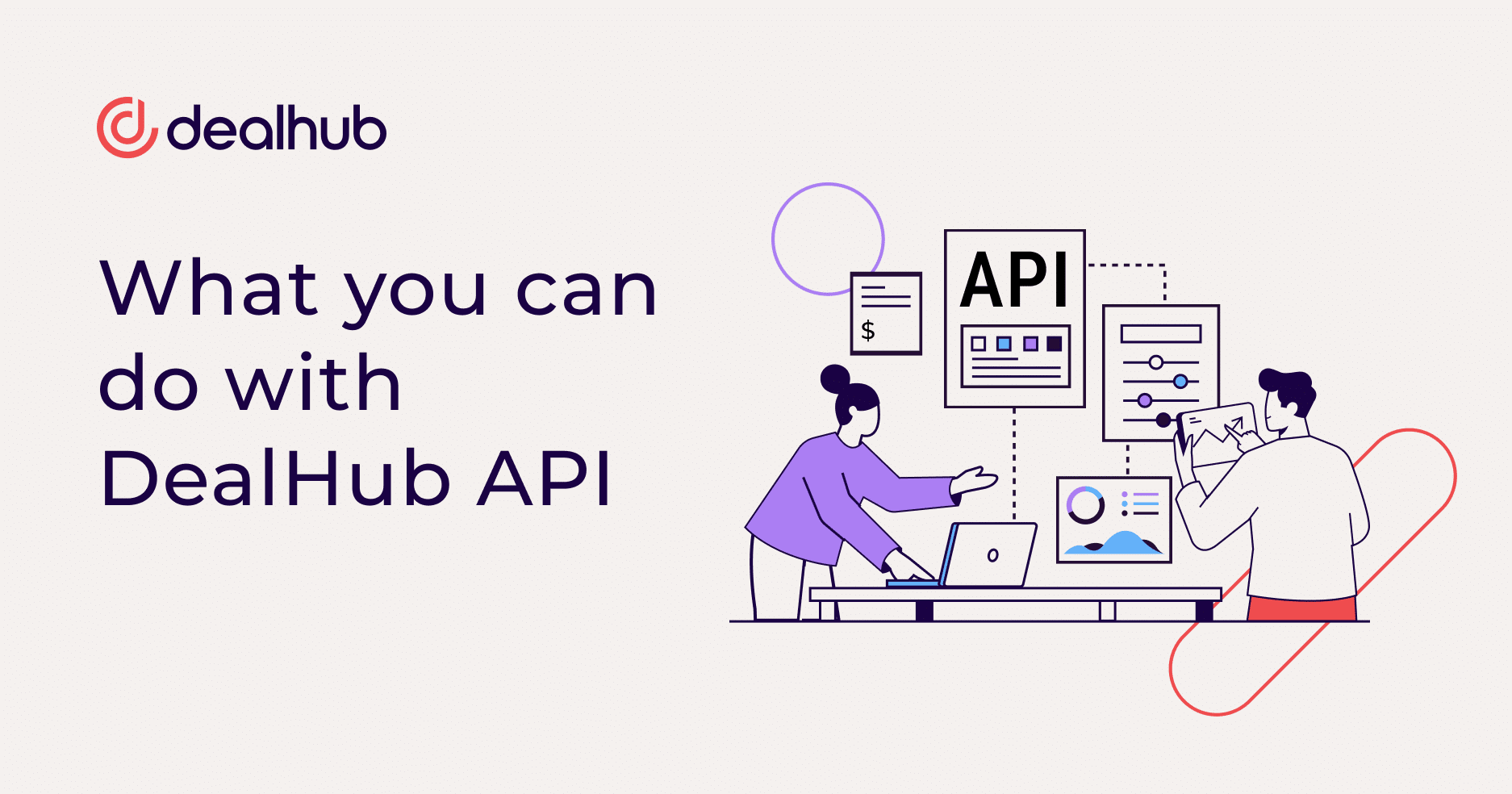AI enhances efficiency, accuracy, and speed across the Q2R process and brings innovative capabilities like predictive pricing, automated contract generation, and intelligent revenue recognition. Here we explore how AI revolutionizes Q2R, setting new benchmarks in business operations and customer engagement.
The Q2R process

The Q2R process, integral to SaaS business model success, encompasses several stages. These include:
Quote generation
This phase involves crafting customized quotes that reflect customer needs and market dynamics. Accurate quoting is requisite for winning business and setting the foundation for a profitable relationship.
Contract and subscription management
Following quote acceptance, the focus shifts to formalizing agreements through contract generation and managing subscriptions. This stage delineates service terms and contributes to consistent revenue flow.
Billing
The billing stage involves generating invoices that accurately reflect the contract terms. This step is pivotal for maintaining cash flow and trust, as it involves frequent customer interactions and financial transactions.
Revenue recognition
In this concluding phase, businesses recognize and record revenue in their financial statements. Adhering to accounting standards and regulations during this stage ensures accurate financial reporting and helps maintain investor and stakeholder confidence.
Importance of Q2R optimization
In SaaS, efficiency and accuracy in the Q2R process can significantly impact a company’s growth trajectory and market positioning. An optimized Q2R process guarantees a swift and smooth transition from initial quotes to revenue recognition, vital for maintaining a steady cash flow – the lifeblood of any growing business.
The need to reduce costs is paramount in this optimization. An efficient Q2R process minimizes operational expenses by streamlining workflows and reducing manual tasks, especially in quoting and contract management for complex contracts. By automating these processes, companies can allocate resources more effectively, focusing on strategic initiatives rather than administrative tasks.
Equally important is the reduction of errors. Inaccuracies in quoting can lead to lost revenue or damaged customer relationships. Similarly, mistakes in subscription management can result in billing errors, impacting customer satisfaction and retention. For SaaS companies, where customer acquisition and retention are the lifeline of the business, such errors can be detrimental to the top-line revenue.
Furthermore, the Q2R process significantly influences revenue recognition, essential for SaaS companies given their subscription-based revenue models. Effective revenue recognition practices ensure compliance with accounting standards and provide accurate revenue forecast reports that aid in strategic decision-making and attracting investors.
The role of AI in quote-to-revenue

Artificial Intelligence (AI) is transforming the Q2R process, offering SaaS companies a powerful tool to stay ahead in a competitive market. AI technologies enhance each phase of the Q2R process, from quoting to revenue recognition, by introducing automation, precision, and personalization.
AI can analyze historical data and customer behavior in the quoting phase to generate accurate and personalized quotes. This speeds up the quoting process and increases the likelihood of conversion by tailoring offers to customer needs.
Contract management is another area where AI is making a significant impact. AI-driven tools can automate contract creation, ensure compliance, and expedite approvals. This reduces the time spent on contract administration, allowing companies to focus on customer engagement and business development.
Billing and subscription management also benefit from AI. AI can optimize billing cycles and subscription billing plans by analyzing customer usage patterns and preferences, enhancing customer satisfaction and improving retention rates.
Finally, AI is instrumental in accurate and compliant revenue recognition. AI systems can process complex revenue recognition rules, handle varying subscription terms, and adapt to evolving accounting standards, ensuring that revenue is recognized correctly and promptly.
Competitors in the SaaS space are increasingly leveraging technology to optimize their Q2R processes. These advancements are not just about staying competitive; they are about redefining the standards of operational efficiency and customer satisfaction in the SaaS industry.
Let’s take a closer look at the value of AI in predictive pricing, contract management, and revenue recognition.
Predictive pricing
AI-driven predictive pricing plays a crucial role in setting optimized prices for products and services. This sophisticated approach involves the analysis of large datasets to identify pricing trends, customer preferences, and market dynamics. Machine learning and AI algorithms can process historical sales data, competitor pricing, customer behavior, and market conditions to predict optimal pricing points. It would be impossible to achieve this level of analysis manually. However, using predictive pricing companies can dynamically adjust their pricing strategies in real time, creating innovative deals and maximizing revenue and market share.
For instance, AI can forecast how price changes will affect customer demand and adjust pricing to capitalize on market opportunities or mitigate risks. Using machine learning for price optimization is particularly useful in subscription-based models to understand and anticipate customer willingness to pay.
A notable example of AI-driven predictive pricing is in the airline industry. Airlines use AI to analyze factors like booking patterns, seasonality, and competitor pricing to dynamically adjust fares. Similarly, e-commerce platforms employ AI to optimize product pricing based on real-time supply and demand.
Automated contract generation
Integrating AI in automated contract generation is a game-changer for the Q2R process, particularly in streamlining subscription management. The complexity and variability of subscription contracts in the SaaS industry demand a level of precision and efficiency that AI-powered automation can uniquely provide.
AI in contract generation involves using intelligent systems to create, customize, and manage contracts. These systems can extract key data points from customer interactions or CRM systems to generate personalized contracts. This automation significantly reduces the time and effort involved in contract creation, allowing sales teams to focus on customer engagement and strategic initiatives.
Moreover, AI-driven contract automation ensures consistency and compliance with legal standards and company policies. It minimizes human error, thereby reducing the risk of contractual disputes or compliance issues. Automated workflows can also facilitate quicker contract approvals, accelerating the sales cycle.
A real-world example of this can be seen in the telecommunications industry. Companies in this sector often deal with complex, multi-tiered subscription models. By employing AI for contract generation, these companies can quickly produce accurate and customized contracts for different service tiers, ensuring compliance and customer satisfaction.
In the legal field, AI-driven contract automation is also increasingly being adopted. Law firms and legal departments use AI tools to draft standard contracts, freeing up time for attorneys to focus on more complex legal work. This streamlines internal processes and provides clients with faster and more cost-effective services.
Intelligent revenue recognition
Intelligent revenue recognition is another example of AI revolutionizing the Q2R process. For RevOps teams, especially in sectors like SaaS where revenue streams can be varied and complex, the role of AI in ensuring accurate and timely recognition of revenue is becoming increasingly critical.
AI-driven revenue recognition involves using advanced algorithms to analyze contracts, service agreements, and customer usage data to accurately recognize revenue in compliance with accounting standards such as ASC 606 and IFRS 15. These standards require revenue to be recognized as performance obligations are fulfilled, which can be complex given the varying nature of contracts and customer agreements in the SaaS world.
One of the key benefits of AI in this domain is its ability to handle large volumes of data and complex calculations quickly and accurately. For example, in subscription-based models, AI systems can track customer usage and subscription changes over time, ensuring that revenue is recognized in line with the delivered service and providing real-time visibility into revenue streams for forecasting.
A practical application of this can be seen in companies with usage-based pricing models. AI systems can automatically track usage data and apply the appropriate revenue recognition rules, adjusting for any upgrades, downgrades, or cancellations in service. This revenue recognition automation significantly reduces the administrative burden and potential for error compared to manual processes.
Unifying quote-to-revenue
A unified Quote-to-Revenue platform, like DealHub, offers a comprehensive solution for optimizing the Q2R process. By integrating various stages of the Q2R journey – from quoting to revenue recognition – into a single platform, DealHub provides a seamless, efficient, and error-free process that contributes to the success of RevOps teams.
One of the key advantages of a platform like DealHub is its ability to centralize and streamline operations. It eliminates the need for multiple disparate tools, which can often lead to data silos and inefficiencies. With everything housed in one platform, RevOps teams have a holistic view of the entire Q2R process, leading to better coordination, faster turnaround times, and improved accuracy.
Moreover, DealHub’s platform is designed to be flexible and scalable, accommodating the evolving needs of growing businesses. Whether it’s managing complex pricing strategies, automating contract generation, or ensuring accurate revenue recognition, DealHub’s platform adapts to each organization’s unique challenges and requirements.
The integration of AI within such platforms further enhances their capabilities. AI-driven analytics and automation offer insights and real-time efficiency impossible with manual processes. For instance, predictive analytics can aid in formulating more effective pricing strategies, while AI-driven contract management can ensure compliance and speed up the contracting process.
For RevOps leaders looking to enhance their Q2R process, adopting a unified platform like DealHub is a strategic move. It simplifies and streamlines operations and provides the data-driven insights and agility needed to thrive in today’s competitive business environment. As the landscape of sales and revenue operations continues to evolve, having a robust, integrated Q2R solution will be a key differentiator for successful companies.









